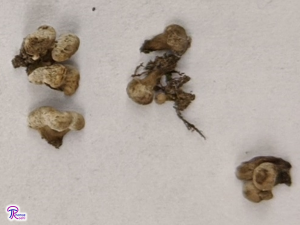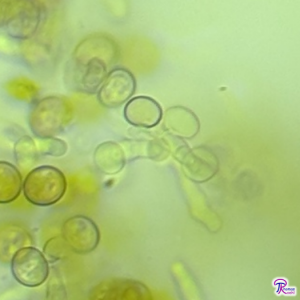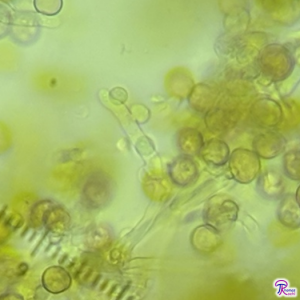#233: Phleogena faginea

Phleogena faginea is a bizarre little mushroom. This tiny grey-brown mushroom grows on wood or bark, making it rather difficult to spot. Even when you do find it, you’d probably think it’s a slime mold (FFF#053): the fruitbody features a round head on a small stalk, much like many slime molds. Despite that similarity, P. faginea is a basidiomycete and its closest relatives are the rust fungi (FFF#130) – something you probably wouldn’t guess by looking at the mushroom. P. faginea goes by the common name of “Fenugreek Stalkball,” which is a reference to its shape (ball on a stalk) and fenugreek or curry-like odor when dried.1–3
Description
P. faginea produces mushrooms that have a rounded head and a more or less cylindrical stipe. The musP. faginea produces mushrooms that have a rounded head and a more or less cylindrical stipe. The mushrooms are small, typically growing up to 8mm high and 3mm wide, although the largest ones can get a few centimeters tall (about an inch). Both the head and stipe are irregular, never quite the same in any two mushrooms. The head is white to greyish to tan and mostly spherical. It is usually not a perfect sphere; most specimens are flattened or elongated or furrowed slightly. The stipe is about the same color as the head (though it might be lighter or darker) and roughly cylindrical. Stipes grow up to 0.5mm thick and are normally flattened or furrowed to make them not true cylinders.1,2 One of the more distinctive features of P. faginea is that if you collect several specimens, dry them, and put them in a jar they should give the air in the jar an odor reminiscent of fenugreek or curry.2,3 I have tried smelling them outdoors with no luck, so you really do need to dry them and put them in a container to experience this.

Ecology
P. faginea decomposes the wood of hardwoods. It is usually saprobic and most often appears on dead wood, but it may also be a weak parasite because it can be found on the bark of living trees. The mushrooms appear in the summer and early fall. You can find these mushrooms in eastern NP. faginea decomposes the wood of hardwoods. It is usually saprobic and most often appears on dead wood, but it may also be a weak parasite because it can be found on the bark of living trees. The mushrooms appear in the summer and early fall. You can find these mushrooms in eastern North America and Europe, where it is particularly common in northern forests.1,2 There are a few records outside this range, so P. faginea may be more widespread than we realize.4,5
Similar Species
You’re most likely to confuse this species with a slime mold. Slime mold fruitbodies are about the same size and shape, but are much more flimsy and powdery. The head of a slime mold contains spores inside, so trying to cut one open will release the powdery spores. By contrast, P. faginea produces spores on the outside and has firm flesh on the inside.
You could also think that this is an ascomycete. Using a microscope will easily separate it from all ascomycetes, as long as you know what you’re looking for (see the Taxonomy section for more details). Fortunately, the fungus is distinctive enough on its own that you don’t need a microscope to ID it.

The closest ascomycetes in appearance are probably those in Onygena, but that genus decomposes bone and other animal remains and can easily be ruled out. Cudoniella is also similar but is shaped like a hemisphere sitting on a cylinder and tends to be whiter.6 If you aren’t sure, the best way is to check microscopic features. Another option that is easier would be to dry the mushrooms out and see if they develop a curry-like odor (the ascomycetes do not).
Edibility
Why would you want to eat this? Maybe for the odor? Anyway, it’s listed as inedible,1 which probably means nobody has tried it. Don’t bother trying to change that, it is so small I don’t think eating it is worthwhile.
Taxonomy
When you first look at this fungus, you would naturally assume it’s an ascomycete. But, when you look under the microscope you don’t see any asci. Instead, the spores are bourne on the sides of what look like short hyphae. These could easily be mistaken for conidia, also suggesting the fungus is an asco. However, if you notice that the spores are always bourne in groups of four, that leads you to the fungus’ true identity: part of the Basidiomycota! In P. faginea, spores are bourne on cylindrical septate basidia. These basidia don’t look like normal basidia, but just like typical basidia they each produce four sexual spores. Each basidium is separated into four sections by parallel septa (“transversely septate”). These unusual basidia can also be found in some rust fungi. And in fact, P. faginea’s closest relatives are rust fungi.2 Both rust fungi and P. faginea belong to the subdivision Pucciniomycotina.7 This taxonomic rank is a half-step below Basidiomycota, so P. faginea isn’t very closely related to the rusts, but they are its closest significant relatives.

P. faginea doesn’t have many close relatives; its class, order, family, and genus are all small and don’t include any other familiar species. To give you an idea how small this group is, Wikipedia reports that the class Atractiellomycetes contains a grand total of 34 species.8 The genus Phleogena contains only two species: P. faginea and P. sphaerospora.9 P. sphaerospora looks the same but has a black stipe and was described from Sri Lanka in 1867.10 I can’t find any other recorded observations of P. sphaerospora, so I’m not sure it is a truly separate species.
Originally, P. faginea was described growing on the bark of a beech tree, which explains the scientific name faginea (literally, “on beech”).11 P. decorticata is another name you might find, but that is a synonym of P. faginea.12
| Kingdom | Fungi |
| Subkingdom | Dikarya |
| Division (Phylum) | Basidiomycota |
| Subdivision (Subphylum) | Pucciniomycotina |
| Class | Atractiellomycetes |
| Order | Atractiellales |
| Family | Phleogenaceae |
| Genus | Phleogena |
| Species | Phleogena faginea (Fr. & Palmquist) Link7 |
See Further:
https://mushroomobserver.org/name/show_name_description/1193
https://www.jeremybartlett.co.uk/2017/11/23/fenugreek-stalkball-phleogena-faginea/
https://www.inaturalist.org/taxa/203926-Phleogena-faginea
Citations
- Bessette, A., Bessette, A. R. & Fischer, D. W. Mushrooms of northeastern North America. (Syracuse University Press, 1997).
- Zachritz, J. Public Description of Phleogena faginea (Fr.) Link. Mushroom Observer http://mushroomobserver.org/name/show_name_description/1193 (2009).
- Bartlett, J. Fenugreek Stalkball, Phleogena faginea. Jeremy Bartlett’s LET IT GROW blog https://www.jeremybartlett.co.uk/2017/11/23/fenugreek-stalkball-phleogena-faginea/ (2017).
- Fenugreek Stalkball (Phleogena faginea). iNaturalist https://www.inaturalist.org/taxa/203926-Phleogena-faginea.
- Occurrence Map for Phleogena faginea (Fr.) Link. Mushroom Observer https://mushroomobserver.org/name/map/14987.
- Beug, M. W., Bessette, A. & Bessette, A. R. Ascomycete fungi of North America: a mushroom reference guide. (2014).
- Phleogena faginea. Mycobank http://www.mycobank.org/name/Phleogena%20faginea&Lang=Eng.
- Atractiellomycetes. Wikipedia (2020).
- Phleogena. Mycobank http://www.mycobank.org/BioloMICS.aspx?TableKey=14682616000000067&Rec=59810&Fields=All.
- Berkeley, M. J. & Broome, C. E. Enumeration of the fungi of Ceylon. The Journal of the Linnean Society. Botany. 14, 29–140 (1875).
- Link, H. F. & Willdenow, K. L. Handbuch zur Erkennung der nutzbarsten und am häufigsten vorkommenden Gewächse /. vol. v.3 1–564 (Spenerschen Buchhandlung, 1833).
- Phleogena decorticata. Mycobank http://www.mycobank.org/BioloMICS.aspx?TableKey=14682616000000067&Rec=309829&Fields=All.







![#011: Characteristics of Kingdom Fungi [Archived]](https://www.fungusfactfriday.com/wp-content/themes/hueman/assets/front/img/thumb-small-empty.png)
